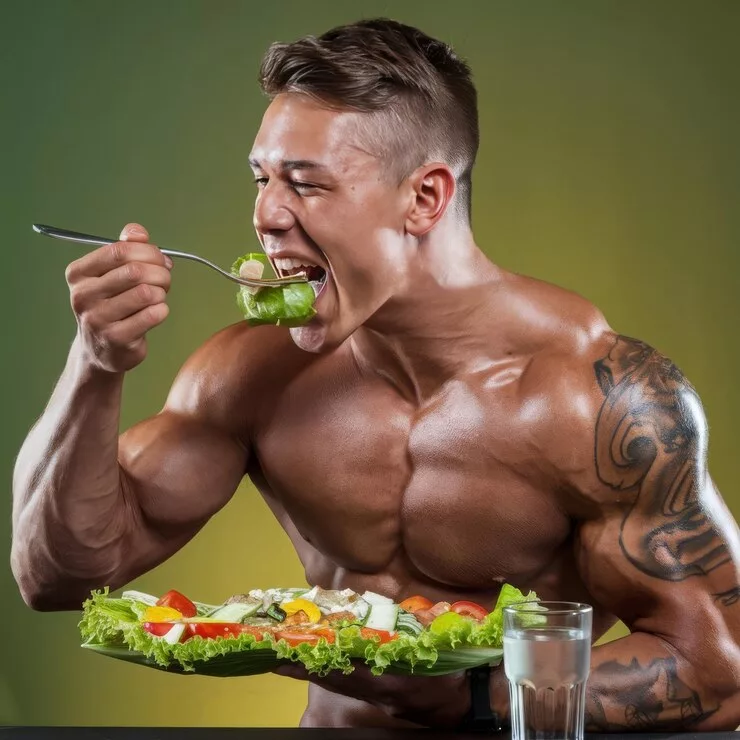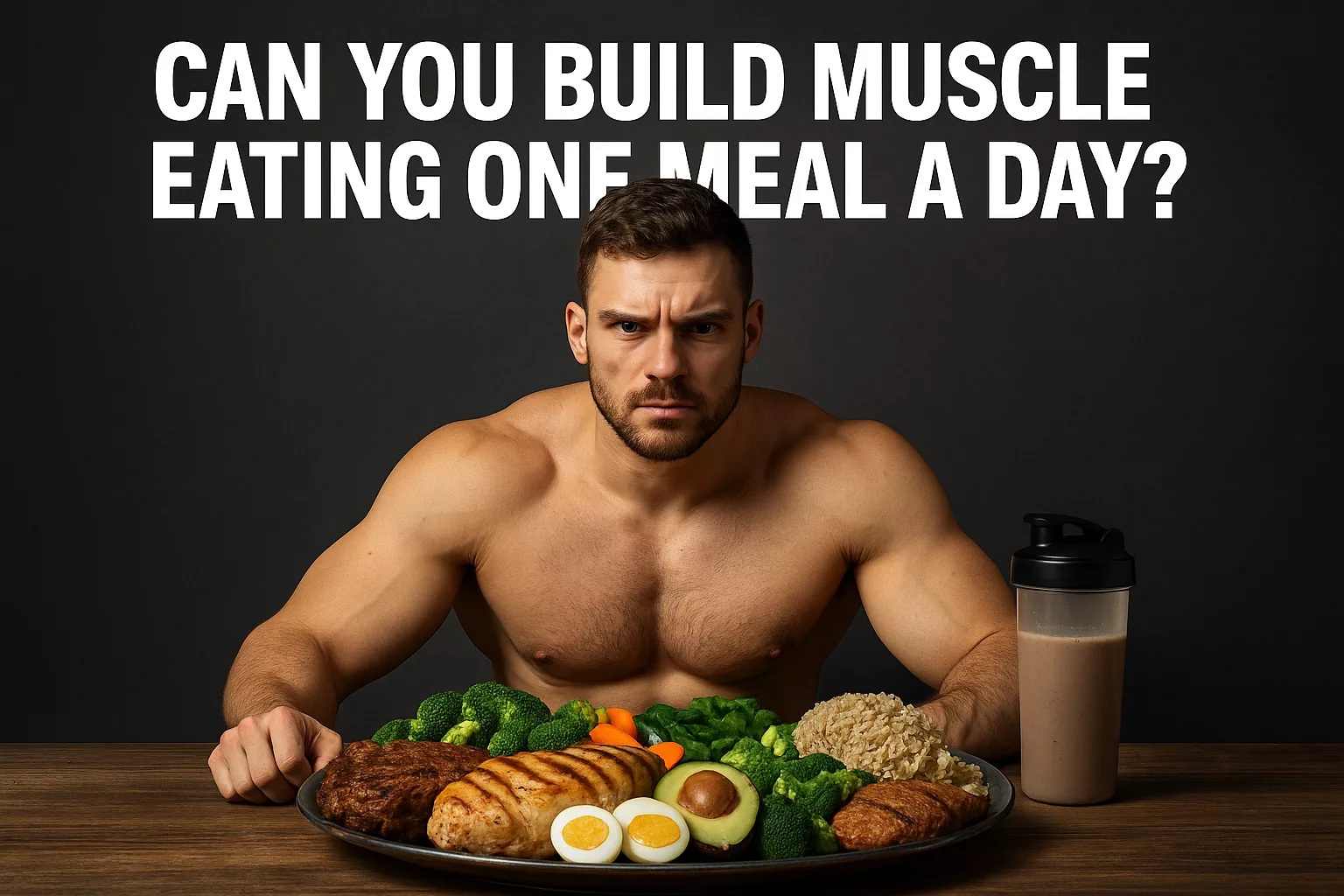Do you know that feeling when you skip breakfast, power through lunch, and finally sit down to a feast that could feed a small army?
Yes, that’s basically what eating once a day feels like.
But the real question is: can you actually build muscle this way?
I mean, a giant, protein-packed meal all in one sitting—can that really fuel those gains?
Let’s find out together.
The madness of OMAD: what is it?

First of all, let’s clarify what OMAD means.
It stands for “One Meal A Day,” and it’s essentially a form of intermittent fasting where you consume all your calories—yes, every last one—in a single glorious feast.
It’s like having Thanksgiving every single day, except you don’t have to fight your aunt for the last slice of pie.
The idea is that by compressing your eating window into one meal, you give your body more time to rest and recover.
Fans of intermittent fasting swear by its benefits: fat loss, mental clarity, and yes, even muscle gain.
But is that last claim really true?
Building muscle 101: what really matters

Here’s the truth: building muscle isn’t just about lifting heavy weights and chugging protein shakes like they’re water.
It comes down to three main factors: calorie intake, protein synthesis, and recovery.
If you eat once a day, you’re cramming all those calories and proteins into one window.
It’s a bit like trying to fill a pool with a fire hose—messy, but potentially effective.
The good news?
Muscle growth is mostly about hitting your daily targets.
If you need 2,500 calories and 150 grams of protein to grow, and you manage to get them all in one epic meal, you’re technically meeting those requirements.
But hold on—there’s more to the story.
Protein absorption: can your body handle it?

You might think, “Okay, I’ll eat a pound of steak, a dozen eggs, and a protein shake, and I’m set.”
I love the enthusiasm, but your body might disagree.
Studies suggest that your body can only effectively use about 20–40 grams of protein per meal.
Anything beyond that is like pouring water into an already full glass.
Sure, some will fit, but most just spill over and… well, get wasted.
That doesn’t mean extra protein is entirely useless—it’ll get burned for energy or, in the worst case, stored as fat.
So if you go all-in with a massive meal, you might not reap all the muscle-building benefits from that 100-gram protein bomb.
Timing matters more than you think
Here’s where things get tricky.
Muscle protein synthesis—the actual building of new muscle fibers—peaks when you consume protein, but it’s not continuous.
It doesn’t run until your next meal.
So if you down 100 grams of protein at dinner and then fast for 24 hours, your muscle-building engine is idle most of the time.
Imagine trying to build a brick wall but only getting bricks once a day.
You might make some progress, but it’s slow, and you spend a lot of time waiting.
If you really want to grow, that downtime isn’t ideal.
The anabolic window: myth or reality?
There’s a lot of hype about the so-called “anabolic window”—that magical post-workout period when your body soaks up protein like a sponge.
While the idea of a strict 30-minute window has largely been debunked, the concept isn’t totally off base.
Your muscles are more receptive to nutrients after training, which means spreading out your protein intake could help more than concentrating it all at once.
That said, if OMAD is your lifestyle, you can still make progress.
You just might not optimize it.
It’s like putting premium fuel in a car but only filling up once a week.
Sure, it’s good for the engine, but you’re not taking full advantage of the performance.
Weekly programming examples with OMAD (One Meal a Day)
Below are two distinct weekly plans: one following the OMAD approach with a single hyper-caloric, hyper-protein meal each day, and another in classic bodybuilder style with multiple meals to maximize muscle anabolism.
Example OMAD (One Meal a Day)
- Monday (Chest & Triceps – Strength)
- Barbell bench press: 4×6
- Incline dumbbell press: 3×8
- Dips: 3×10
- French press: 3×8
- Single meal (post-workout, 6:00 PM):
- 1 kg grilled chicken
- 300 g brown rice
- 200 g steamed vegetables
- 2 hard-boiled eggs
- 1 avocado
- 1 protein shake (40 g protein)
- Tuesday (Back & Biceps – Hypertrophy)
- Deadlift: 4×8
- Barbell row: 3×10
- Wide-grip lat pulldown: 3×12
- Barbell curl: 3×10
- Single meal (post-workout, 6:00 PM):
- 500 g lean beef
- 400 g sweet potatoes
- 150 g mixed vegetables
- 100 g quinoa
- 1 Greek yogurt with nuts
- Wednesday (Rest or Light Cardio)
- Activity: 45 min walk or 30 min cycling
- Single meal (6:00 PM):
- 300 g baked salmon
- 200 g basmati rice
- Mixed salad with avocado
- 50 g nuts
- 1 orange
- Thursday (Shoulders & Abs – Strength)
- Military press: 4×6
- Lateral raises: 3×12
- Rear-delt raises on bench: 3×12
- Leg raises: 3×15
- Fitball crunches: 3×20
- Single meal (post-workout, 6:00 PM):
- 1 kg roasted turkey
- 350 g whole-wheat pasta
- 150 g broccoli
- 2 bananas
- 1 protein shake
- Friday (Legs – Strength & Hypertrophy)
- Squat: 4×8
- Leg press: 3×10
- Dumbbell lunges: 3×12
- Calf raises: 4×15
- Single meal (post-workout, 6:00 PM):
- 600 g lean veal
- 400 g boiled potatoes
- Legume salad
- 3 scrambled eggs
- 1 protein bar
- Saturday (Light Full Body or Cardio)
- Body-weight circuit or 45 min light run
- Single meal (6:00 PM):
- 400 g grilled chicken
- 300 g black rice
- Roasted vegetables
- 1 protein smoothie
- Sunday (Rest & Active Recovery)
- Recovery: Stretching or yoga
- Single meal (6:00 PM):
- 500 g white fish
- 250 g couscous
- Mixed salad
- 2 hard-boiled eggs
- Greek yogurt with honey
Example Classic Bodybuilder (5–6 meals a day)
Monday (Chest & Triceps – Strength & Hypertrophy)
- Exercises:
- Barbell bench press: 4×6
- Incline dumbbell press: 3×8
- Chest press: 3×10
- Dips: 3×12
- Cable triceps pushdown: 3×12
- French press: 3×10
- Typical Meals:
- Breakfast (7:00 AM): 6 egg whites, 1 whole egg, 100 g oats, 1 banana
- Snack (10:00 AM): 100 g almonds, 1 apple
- Lunch (1:00 PM): 200 g chicken, 100 g brown rice, steamed veggies
- Snack (4:00 PM): 1 Greek yogurt, 1 tbsp peanut butter
- Dinner (7:00 PM): 250 g lean beef, 200 g sweet potatoes, mixed salad
- Pre-bed (10:00 PM): 1 protein shake, 30 g nuts
Tuesday (Back & Biceps – Strength & Hypertrophy)
- Exercises:
- Deadlift: 4×8
- Barbell row: 4×8
- Wide-grip lat pulldown: 3×12
- Low-row pulley: 3×10
- T-bar row: 3×10
- Barbell curl: 3×10
- Hammer curl: 3×12
- Typical Meals:
- Breakfast (7:00 AM): 5 egg whites, 1 whole egg, 80 g oats, 1 kiwi
- Snack (10:00 AM): 1 apple, 30 g walnuts
- Lunch (1:00 PM): 200 g turkey, 100 g basmati rice, mixed veggies
- Snack (4:00 PM): 1 Greek yogurt, 1 orange
- Dinner (7:00 PM): 250 g salmon, 200 g boiled potatoes, green salad
- Pre-bed (10:00 PM): 1 protein shake, 20 g almonds
Wednesday (Shoulders & Abs – Hypertrophy)
- Exercises:
- Military press with barbell: 4×8
- Dumbbell lateral raises: 4×12
- Dumbbell front raises: 3×12
- Face pulls: 3×15
- Arnold press: 3×10
- Fit-ball crunches: 3×20
- Leg raises: 3×15
- Typical Meals:
- Breakfast (7:00 AM): 5 egg whites, 1 whole egg, 80 g oats, 1 banana
- Snack (10:00 AM): 1 pear, 30 g cashews
- Lunch (1:00 PM): 200 g chicken, 100 g brown rice, mixed vegetables
- Snack (4:00 PM): 1 Greek yogurt, 1 tbsp honey
- Dinner (7:00 PM): 250 g cod, 200 g sweet potatoes, steamed broccoli
- Pre-bed (10:00 PM): 1 protein shake, 20 g nuts
Thursday (Legs – Strength & Hypertrophy)
- Exercises:
- Barbell squat: 4×8
- Leg press: 4×10
- Dumbbell lunges: 3×12
- Leg curl: 3×12
- Leg extension: 3×15
- Calf raises (standing and seated): 4×15
- Typical Meals:
- Breakfast (7:00 AM): 6 egg whites, 1 whole egg, 100 g oats, 1 kiwi
- Snack (10:00 AM): 1 orange, 30 g nuts
- Lunch (1:00 PM): 250 g lean beef, 100 g basmati rice, mixed vegetables
- Snack (4:00 PM): 1 Greek yogurt, 1 apple
- Dinner (7:00 PM): 250 g chicken, 200 g sweet potatoes, steamed spinach
- Pre-bed (10:00 PM): 1 protein shake, 20 g almonds
Friday (Full-Body Technique & Weak-Point Training)
- Exercises:
- Bench press (chest focus): 3×8
- Barbell row (back focus): 3×10
- Military press (shoulder focus): 3×8
- Light squat (leg focus): 3×10
- Calf raises: 3×15
- Plank: 3×1 minute
- Typical Meals:
- Breakfast (7:00 AM): 5 egg whites, 1 whole egg, 80 g oats, 1 banana
- Snack (10:00 AM): 30 g almonds, 1 apple
- Lunch (1:00 PM): 200 g chicken, 100 g brown rice, steamed vegetables
- Snack (4:00 PM): 1 Greek yogurt, 1 tbsp peanut butter
- Dinner (7:00 PM): 250 g cod, 200 g sweet potatoes, mixed salad
- Pre-bed (10:00 PM): 1 protein shake, 20 g nuts
Saturday (Cardio & Stretching)
- Activity:
- 45 minutes light run or brisk walk
- Deep stretching and foam rolling
- Typical Meals:
- Similar to Friday, alternating protein sources such as fish or legumes
Sunday (Full Rest or Active Recovery)
- Activity:
- Light yoga or dynamic stretching
- Goal: Complete muscular recovery
- Typical Meals:
- Lower carbs, higher healthy fats to support recovery
What’s the main difference?
With OMAD, all your nutrition is concentrated in one meal, demanding meticulous planning to avoid deficiencies and maximize absorption.
With the classic bodybuilder approach, you distribute 5–6 meals throughout the day, providing constant fuel for your muscles and making the most of protein synthesis opportunities.
RELATED:》》》 What happens if you only eat tuna and rice for bulking?
Final considerations: is OMAD worth it for muscle building?
Look, OMAD is fantastic for fat loss and mental clarity.
For muscle building, it’s more of a slow burn.
If you’re okay with that pace, go for it—just make sure you hit your macros, train hard, and stay consistent.
But if you really want to pack on mass—those biceps, that back—consider spreading your protein intake throughout the day.
Because sometimes, a few more bricks at regular intervals is exactly what you need to build a solid wall of muscle.

